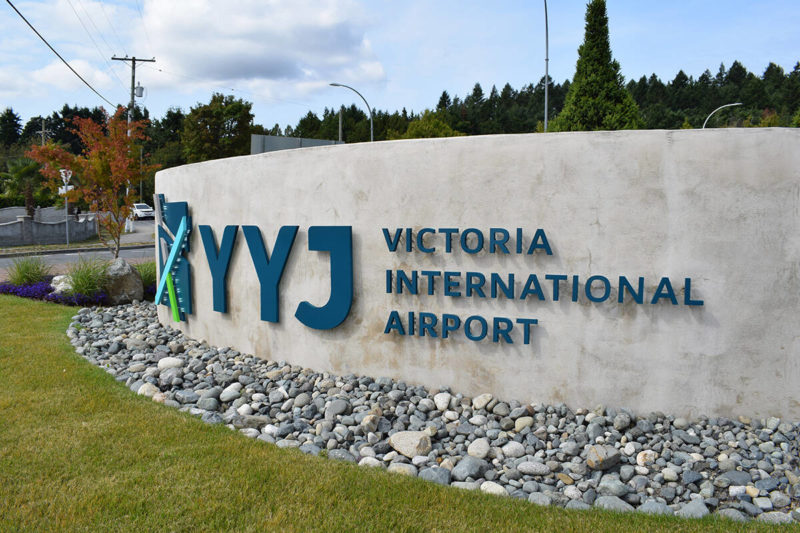Victoria International Airport will likely continue to experience logistical challenges with the looming prospect of airlines passing on rising fuel costs to travellers.
But the airport also finds itself in reasonable financial shape as it welcomes new airlines and builds back routes, especially to sunnier destinations.
Victoria Airport Authority president/CEO Geoff Dickson made the points in his annual report presentation May 9 to Sidney councillors, who also heard construction of the Amazon building on Beacon Avenue West remains on schedule with an unspecified fall completion date.
Perhaps the most pressing news in the presentation concerned the cost of fuel – and with it ticket prices – as airports around the world report shortages.
“We have not had supply problems, but I can tell you that … the overall impact on costs for airlines, the major ones, is about 30 per cent,” Dickson said. “That’s a big expense lift – just the variability of fuel. You will probably see that passed through in prices to a certain extent.”
This said, airlines expect a busy summer season against the backdrop of other shortages, including operations personnel.
Like other airports, YYJ has a shortage of security personnel to screen passengers, baggage and identity cards, Dickson said, adding the Canadian Air Transport Security Authority (CATSA), which staffs the positions, is doing everything it can to deal with the problem.
Victoria is faring better than many other airports, he said, noting two-hour lineups only happen when CATSA does not staff all four lines by 8:30 a.m. “And if they miss that, then it gets quite congested very quickly. So, yes, we are on it. It’s frustrating for us. We would love to see a different business model for CATSA, but it’s the model that the federal government wants to provide.”
CATSA spokesperson Suzanne Perseo said 80 screening officers are employed at the airport and the authority is looking to hire 25 more.
Wait times at any airport, including Victoria International Airport, can occur for various reasons, even when staffing levels are optimal, she said later, adding that they can fluctuate throughout the day based on passenger volume and the number of flights.
“We encourage all passengers to arrive at their departing airport two hours in advance for domestic flights and three hours in advance for US and international flights,” she said.
While Nav Canada does not publish staffing levels for its facilities, media relations manager Brian Boudreau confirmed that “the (control tower) at Victoria International Airport may experience reduced staffing at times this summer due to unplanned absences.”
In some cases, he said, “the pandemic has created additional challenges in maintaining optimum staffing levels as a result of the direct impacts of positive cases or requirements to self-isolate within our teams, as well as unplanned leave and absences.”
Challenges getting to and from the airport were also highlighted by Dickson.
Looking at the broader trends, Dickson is pleased to see passenger numbers picking up. In 2021, the airport served 674,000 passengers, an increase of 17 per cent over 2020. While still just 35 per cent of 2019 figures, when close to two million passengers travelled through the airport, that ratio is among the best in the country, he said.
The airport also added new routes from ultra low-cost carriers like Flair Airlines, Swoop, Lynx with another potentially joining in 2023. Dickson expects these airlines to make up 15 per cent of domestic traffic in the summer of 2022, up from five per cent in summer 2019. “You will start to see more and more of those aircraft coming and more non-stop markets opening up for Victoria.”
As for other markets, one area of focus is building back the number of sun spot flights to Mexico. The airport would also like to add routes into Central Canada as well as the North American West Coast, Las Vegas and Phoenix. “And we are in conversation with United Airlines right now about building into their hub in Denver,” Dickson said.
Despite his optimism, he acknowledged COVID-19 remains a source of uncertainty with an ongoing financial legacy.
The pandemic has reduced the airport’s overall revenue by $50 million since 2020 and led to a $5.4-million loss in 2021, a year that saw the authority receive some $6.5 million in government assistance. “So not a very pretty picture.”
Plan your adventures throughout the West Coast at westcoasttraveller.com and follow us on Facebook and Instagram @thewestcoasttraveller. And for the top West Coast Travel stories of the week delivered right to your inbox, sign up for our weekly Armchair Traveller newsletter!











 New beer festival on tap this summer in Greater Victoria
New beer festival on tap this summer in Greater Victoria